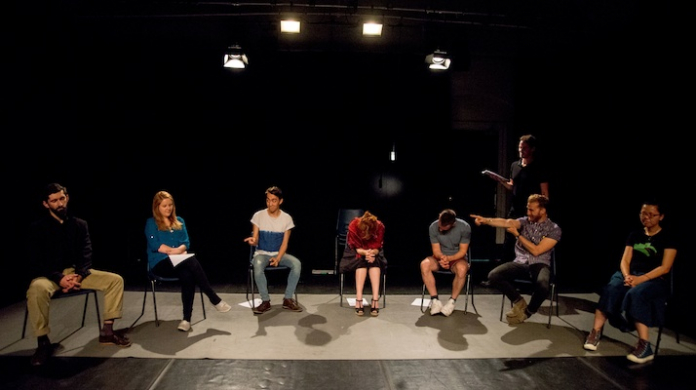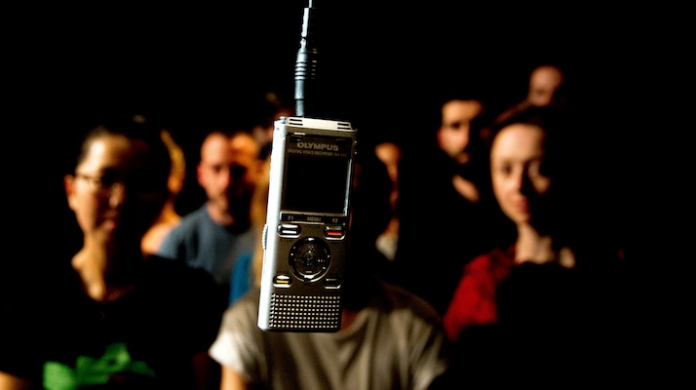Director Ramin Gray talks about working with Iranian writer Nassim Soleimanpour on his new piece, Blind Hamlet, and the differences between English and Iranian approaches to theatre and story
Storytelling machines
I went to see Nassim Soleimanpour’s piece White Rabbit Red Rabbit, and during the show he handed out his email address. So, I contacted him and began a conversation with him about theatre. He lives in Iran and I live in London, but I’m half Iranian and I’ve worked a lot in new writing, so I knew some of the people he admired. It was a conversation not about being Iranian so much, but about contemporary theatre. As it turned out we had twin loves, which were the game, ‘Mafia’ and the play Hamlet, and he had the idea of trying to thread one through the other. I thought that was a really bold idea.
"It’s been a very long journey, much longer than it would normally be in theatre, because it’s been very hard to meet."
It’s been a very long journey, much longer than it would normally be in theatre, because it’s been very hard to meet. In the last two or three years it’s been very hard for English people to get Iranian visas and vice versa. We met twice in Istanbul, we met in Vienna, but with the British Council’s support we were finally able to get him to the UK, the first time he’d ever been here. If you know his previous play, White Rabbit Red Rabbit, it’s all about the fact he couldn’t leave Iran because he didn’t have a passport, as he hadn’t done military service. But in fact, after he wrote that play he went for an eye test and was told he had a degenerative eye disease, so he was excused military service and given a passport.

Blind Hamlet rehearsal
After this he phoned me up one day, very excited, and said that the title should be Blind Hamlet. And I can see, of course, why it makes sense for this particular writer, this issue, ideas around blindness, seeing, not seeing, wondering whether or not what you see is the truth. As Shakespeare says in in the play, “One may smile and smile and be a villain”.
"Sometimes when you’re working in English in England you forget the status of Shakespeare as a world talent..."
Sometimes when you’re working in English in England you forget the status of Shakespeare as a world talent. When you think of the Mona Lisa you don’t think about it specifically as an Italian painting, it belongs to us all, and I think Shakespeare is like that as well. I don’t think Shakespeare should be dragged into the twenty-first century, or repurposed, because it’s totally fit for purpose, there’s nothing wrong with it. It’s sort of out of time – Shakespeare has transcended time.
It’s interesting that Nassim would gravitate to this play, because it is the play, and it contains the line of all lines, probably the most famous line in world drama. I don’t know if it will be in this version or not, it sort of doesn’t need to be. There is no-one who hasn’t heard that line. Very little of the original script of Hamlet remains in this piece – it’s not a version of Hamlet. It takes the image of Hamlet as a jumping off point, and it also builds on some of the formal games Nassim was playing with White Rabbit Red Rabbit.

Blind Hamlet
The game of Mafia, which is the second point of inspiration for the piece, is a very sophisticated version of Wink Murder, where you try to figure out who’s who, what their identity is, what they’re trying to do, and whether they trying to kill you. Are they with you or against you? So you can see that the struggle at this stage, just before we open a rough version of the show, is how to turn that into a piece of theatre. That’s what we’ve been wrestling with.
"This time there has been no script, actors or rehearsal room, so that’s interesting and pretty risky, and very different."
What I thought was interesting about Nassim as a writer is that he dispenses with the rehearsal process, and so his goal is to try to destroy my job! Working with Nassim is quite curious, totally unlike anything I’ve ever done. Most of my life I’ve gone into rehearsal with actors, and I may be a good or bad director, but I do know how to do that. This time there has been no script, actors or rehearsal room, so that’s interesting and pretty risky, and very different. Part of me has chafed against the routine of being in a rehearsal room with actors trying to get through the play.
This is more like making a play in Nassim’s head and then trying to get it out of his head and into some form that we can play in the theatre. Most of my work so far has been about devising and having dramaturgical discussions with him. I think at this point it will also be something without actors, and the idea is maybe to get the audience involved, building on White Rabbit Red Rabbit. We’ve had lots of test audiences and trials, and we spent a week and a bit working with actors, so we’ve been through lots of iterations and possibilities, and we’re still not necessarily there. We open tomorrow with something, and then take stock.
"I’ve learned about Shakespeare, and I’ve learned quite a lot about Iran."
I’ve learned several different things during this process. I have re-learned some lessons about role, asking myself what I’m best placed to do, what I do best, what the other person does best. I’ve learned about Shakespeare, and I’ve learned quite a lot about Iran. I’ve got to know Nassim pretty well as an Iranian in the particular culture and time that he’s coming out of, and about what’s driving him to make these particular things in this particular way.
One of the theatre laws is never to work with children or animals, because they will just be themselves and they will shred any kind of reality you’re trying to construct. And I think that’s one of the things that attracts me to Nassim, that he’s got a very strong instinct always to be honest with an audience, a lack of artifice, and by going into that maybe creating quite a sophisticated artifice but it starts to happen in a different way.
I think he’s quite related in that sense, taste-wise, or aesthetically, to Iranian filmmakers like [Abbas] Kiarostami or [Mohsen] Makhmalbaf, who have a very sophisticated and highly developed sense of reflexivity. A lot of Iranian cinema is very like cinema verité, very real, very low-fi. There’s a very sophisticated dialogue going on between Kiarostami and Makhmalbaf – they make movies where they talk about each other, a bit like Goddard and Truffaut at that time. The conversation is part of the making of the work.
"We've all got stories, which is why it’s interesting to work with real people, that’s what we do, that’s what audiences do."
I think Nassim comes in that align of artists, which is very tricky to do in English because the English don’t hold much truck with that. The English, on the whole, tend to label that as a slightly pretentious thing, and they like to be swept up into narrative and stories. What I like is stripping back – that’s not to say you don’t then get to a story, because it’s theatre and there’s got to be a story in the end. We’ve all got stories, which is why it’s interesting to work with real people, that’s what we do, that’s what audiences do. We are storytelling machines.
Credits
Ramin Gray is the Artistic Director of Actors Touring Company (ATC), and is currently directing Nassim Souleimanpour's Blind Hamlet. He was speaking to Eleanor Turney. On Twitter, you can follow ATC as well as @UKTheatreDance for all the latest blogs, news and opportunities from the British Council Theatre and Dance team. Blind Hamlet is being performed at the Edinburgh Fringe until 23 August.


